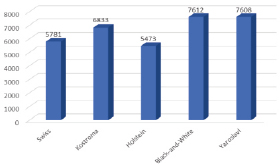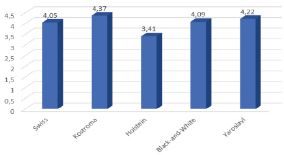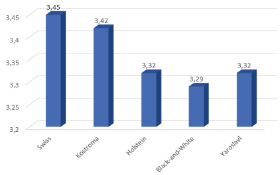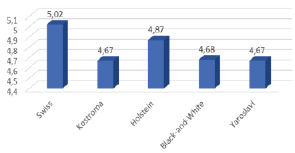Raw milk is a nutritious drink that benefits human health and is available for a daily diet. Raw milk has been used by humans for a long time, being an excellent source of digestible vitamins and minerals, as well as useful nutrients that people need. The value of milk for humans was noted in ancient Greece by Hippocrates: “In milk is perfection.” And the great Russian physiologist I.P. Pavlov said that “milk is an amazing food prepared by nature.”
Providing population with high-quality dairy products is one of the tasks in the complex program of sustainable development of the country’s economy, solved by both producers and processing enterprises [1]. Undoubtedly, the real progress here is due, among other activities, to the organization of scientific research and the accumulation of scientific knowledge about the composition of milk and the productivity of the dairy herd.
Modern research and analysis methods allow us to determine the components of milk as well as their quantitative indicators. It is this area of livestock technology that is in the focus of our scientific attention [2]. It has been established that the main easily digestible and well-balanced components of milk – fat, protein, milk sugar – indicate not only its nutritional value, but also, as a basis for the pricing policy of dairy products, are of economic interest [3, 4].
The naturalness of milk and its suitability for processing into dairy products depend on the physical and chemical components. Achieving high results in improving the composition and quality of milk produced is provided by the complexity of problem solving. These are taking into account genetic factors, introducing new production technologies, effective methods of milking, keeping animals, advanced training for workers and systematic monitoring of the animal’s health and conditions of their keeping [5, 6, 7]. All of the above factors ensure the formation of a herd with high productivity under conditions of intensive use of animals. Milk yields, fat and protein content in milk are necessary parameters for the selection of animals for breeding, influencing also economic effect of dairy production [8].
Goals and objectives
Since the amount of the main components of milk can vary significantly depending on the particular animal, its breed, stage of lactation, age and state of health, we initiated a comparative analysis of the chemical composition of milk in cows of the Kostroma, Black-and-White and Yaroslavl breeds. In this regard, we were interested in the experience of foreign colleagues who conducted similar studies. As a result of the preview, two articles presenting comparative analysis of milk chemical composition indicators in cows of Swiss and Holstein breeds [9, 10].
The purpose of our research is to study the qualitative composition of milk from cows bred in the Kostroma region, comparative analysis being used. To achieve the goal, the following tasks were set:
– to compare the chemical composition and evaluate the nutritional value of milk in cows of selected breeds;
– to evaluate the milk productivity of cows of different breeds.
Material and methods of research
The research material was the data from the primary breeding and zootechnical records for 2018, provided by LLC “Minskoye” (the Kostroma district, the Kostroma region), as well as data retrieved articles by foreign authors on physical and chemical composition of milk in cows of the breeds being of interest to us.
In the course of the study, the method of theoretical review of domestic and foreign literature was applied. The method of comparative analysis was used to describe the qualitative and quantitative composition of milk in cows of different breeds and assess its nutritional value. These methods are important in the development of professional competencies of specialists in various sectors of agriculture [11].
Research results and discussion
In recent years, the gene pool of Holstein cattle has been used to improve the productive qualities of Black-and-White and Yaroslavl breeds. One of the most productive in the world is the Holstein breed of dairy cattle of the USA and Canada, characterized by a specialized dairy type. Holstein black and white cows, like their analogues, have high milk yields that exceed other breeds [12].
Kostroma breed being of the same origin as the brown Swiss breed shows good performance in the dairy production [13]. The milk of these breeds is rich in fat and protein and has a more favorable balance of these components. Holstein cows and Holstein cattle are inferior in terms of the total indicator of milk fat and milk protein to the brown Swiss and Kostroma breeds.
The selection of animals for intensive use must be carried out based on economic characteristics such as milk yield, the content of fat and protein in milk.
Cows of different breeds are characterized by different levels of milk productivity; the composition of milk also can be different, both of the factors affecting the technological properties of milk.
Milk productivity is estimated by milk yield and fat content in milk. However, foreign breeders consider milk protein as a factor reflecting the food value of milk. The content of both fat and protein in milk characterizes the nutritional value of milk, as well as how much and what quality dairy produce from it will be.
The main objective of an agricultural enterprise is to increase milk production and improve its quality, the potential of the cow being considered. The composition of milk determines its biological and nutritional value; the yield of dairy produce and its quality also depend on it. The study of milk productivity is associated with the study of certain indicators such as milk yield, the content of fat, protein and lactose in milk.
As can be seen from Table 1, the milk yield of cows of holsteinized black-and-white breed exceeded the milk yield of the compared animals and accounted for 7612 kg. According to the content of fat and protein in milk, cows of the Kostroma and Swiss breeds had the highest parameters and accounted for 4.37 % and 3.45 %, respectively. The amount of milk sugar in the milk of cows of the Swiss breed accounted for 5.02 %.
The widened analysis of milk components values is given in diagrams (Fig. 1-4).
Fig. 1 shows that the milk yield of cows of the Holstein black-and-white breed accounted for 7612 kg and exceeded the milk yield of the compared Yaroslavl breed (Mikhailovsky type) by 0.1 %. While this parameter is lower by 10.2 % in analogues of the Kostroma breed, by 24 % in the Swiss breed, and by 28 % among representatives of the Holstein breed.
The chemical composition of milk determines its nutritional properties. The taste and technological properties of milk are affected by fat, milk protein and lactose.
Milk fat determines the nutritional value of milk, its energy value; it determines the digestibility of milk and technological properties in the manufacture of dairy produce.
From fig. 2 it follows that the milk of cows of the Kostroma breed has the highest fat content and accounts for 4.37 %, which exceeds the analogues of the improving breed (the Swiss breed) by 0.32 %, and the cows of the Holstein breed and breeds improved by it (black-and-white and Yaroslavl breeds) by 0.96 %, 0.28 % and 0.15 %, respectively.
Comparison of milk productivity indicators values for cows belonging to different breeds
|
Indicators |
Breed |
||||
|
swiss |
kostroma |
holstein |
black-and-white |
yaroslavl |
|
|
Milk yield, kg |
5781 |
6833 |
5473 |
7612 |
7608 |
|
Fat, % |
4,05 |
4,37 |
3,41 |
4,09 |
4,22 |
|
Protein, % |
3,45 |
3,42 |
3,32 |
3,29 |
3,32 |
|
Lactose, % |
5,02 |
4,67 |
4,87 |
4,68 |
4,67 |

Fig. 1. Comparative diagram for milk yield in cows of different breeds

Fig. 2. Fat content in milk of compared cow breeds

Fig. 3. Protein content in milk of compared breeds
The protein contained in milk is characterized by balanced amino acids, which allow the production of various products from milk and determine the quality of milk as an independent product, as well as dairy produce in general. High protein milk is of higher value for the making dairy products such as cottage cheese and cheese.
According to Fig. 3, cows of the Swiss breed are leading in terms of protein content in milk, which accounts for 3.45 %. This parameter is higher than that of the compared cow breeds: by 0.03 % in cows of the Kostroma breed, by 0.13 % in cows of the Holstein breed, by 0.16 % in cows of the Black-and-White breed and by 0.13 % in cows of the Yaroslavl breed.

Fig. 4. Milk sugar content in milk of the compared breeds
The data of Fig. 4 show that milk sugar in milk (which has technological significance), was 5.02 % in cows of the Swiss breed and exceeded this parameter in cows of the Kostroma and Yaroslavl breeds by 0.35 %, in cows of the Holstein breeds by 0, 15 % and in cows of the Black-and-White breed – by 0.34 %.
Conclusion
Analyzing the collected material, we can draw the following conclusion. The milk productivity of the cows studied has breed variation. Knowing its causes, it is possible to control cows’ productivity achieving a systematic increase.
The quality of milk and its nutritional value directly depend on genetic and paratypical factors. To obtain milk yields of milk with a high content of fat and protein, it is necessary to cross Black-and-White and Yaroslavl breeds with Holstein. An increase in the potential for milk productivity in cows of the Kostroma breed is possible due to the hybridization of blood from the Swiss breed.
Библиографическая ссылка
Sevostyanova E.A., Krasilshchik E.A. COMPARATIVE ANALYSIS OF MILK AND ITS NUTRITIONAL VALUE // European Journal of Natural History. 2020. № 3. С. 34-37;URL: https://world-science.ru/ru/article/view?id=34082 (дата обращения: 04.12.2025).

